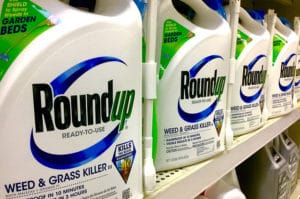

| Online: | |
| Visits: | |
| Stories: |

| Story Views | |
| Now: | |
| Last Hour: | |
| Last 24 Hours: | |
| Total: | |
Lawsuits Against Monsanto Abound
Cornucopia’s Take: In 2015 the World Health Organization’s International Agency for Research on Cancer found some “evidence of carcinogenicity,” linking glyphosate with lymphoma and opening the door for lawsuits. Some have drawn a parallel with asbestos and tobacco.
Roundup’s active ingredient facing wave of legal challenges as alleged carcinogen
St. Louis Post-Dispatch
by Bryce Gray
 |
Glyphosate, the active ingredient in Monsanto’s marquee product, Roundup, is coming under fire from hundreds of legal challenges across the U.S., with individuals alleging that the herbicide is carcinogenic and linked to cases of non-Hodgkin lymphoma.
Whether the cases pay out for plaintiffs remains to be seen. But at the very least, they represent a big opportunity for litigators, with some thinking “glyphosate” could become a legal buzzword on par with asbestos.
“They certainly do see these Roundup cases as following the trajectories of asbestos, PCBs, and tobacco,” said Carey Gillam, a director of the consumer group U.S. Right to Know, who is following the cases and has researched Monsanto for years. “They see thousands and thousands of potential plaintiffs, not just in the U.S., but around the world.”
Litigators working on the cases say the basis for the allegations is a 2015 report issued by the World Health Organization’s International Agency for Research on Cancer that concluded “there was limited evidence of carcinogenicity” associating glyphosate with lymphoma, the cancer of the immune system.
“When IARC says something is carcinogenic, it’s generally carcinogenic,” said Tim Litzenburg, an attorney with The Miller Firm, a Virginia-based law office filing many of the cases. “They’re the authority.”
Between state and federal courts, Litzenburg says hundreds of cases have already been filed in the U.S., but he believes that total will balloon over the coming weeks.
“Six to eight weeks from now they could number in the thousands,” Litzenburg said.
He says the sudden surge is from the fact many states have a statute of limitations that allows individuals two years to file a lawsuit from the date on which they learned of a possible health connection to a certain product. Given the March 2015 release of the IARC report, that two-year window is closing and the cases are streaming in.
The alleged victims are primarily agricultural and landscape workers who Litzenburg says have used glyphosate consistently for years.
Even though glyphosate’s patent expired years ago and it is now produced generically, Litzenburg says the cases target Monsanto, the Creve Coeur-based biotech and seed giant. The company developed the chemical in 1970 and maintained the patent until its expiration in 2000.
But the cases face a fierce legal challenge and a hefty burden of proof.
Monsanto officials say the cases are not supported by the weight of scientific evidence, noting that glyphosate won previous lawsuits about its safety in the 1980s. They also paint the IARC report as an unfounded anomaly, pointing out that hundreds of governments, agencies and studies have been unable to establish health risks and have approved the chemical for use.
Since the release of the IARC study, for instance, the Environmental Protection Agency, the European Food Safety Authority, and a joint meeting of the United Nations’ Food and Agriculture Organization and the WHO’s separate group that studies pesticide residues have all stated that glyphosate is not likely to be carcinogenic to humans.
“When you look at this outlier claim by IARC, it stands in stark contrast to a 40-year history of safe use of glyphosate around the world,” said Scott Partridge, a vice president of global strategy for Monsanto.
Even those critical of Monsanto, like Gillam, recognize the challenges ahead of the glyphosate suits, but she thinks a compelling case is being assembled.
“Initially when these cases started to be filed, I was skeptical because Monsanto has such a strong track record of prevailing in court,” said Gillam. “But the more information that comes out through discovery and new scientific research that’s emerging, the more it looks like the plaintiffs may have a case,” she added, suggesting that risk assessment depends largely on the interpretation of data.
It still has yet to be determined whether the cases will make it to trial. That will not come into focus until after an October court hearing featuring expert testimony from each side. Any possible trial still sits about a year and a half away, according to Litzenburg.
Whatever happens, the proceedings are bound to draw the attention of the legal community, consumer groups and the agriculture industry.
“I feel like this is a movie that I’m watching unfold,” Gillam said. “I don’t know how it’s going to end, but it’s interesting.”
The post Lawsuits Against Monsanto Abound appeared first on Cornucopia Institute.
Source: https://www.cornucopia.org/2017/03/lawsuits-monsanto-abound/


